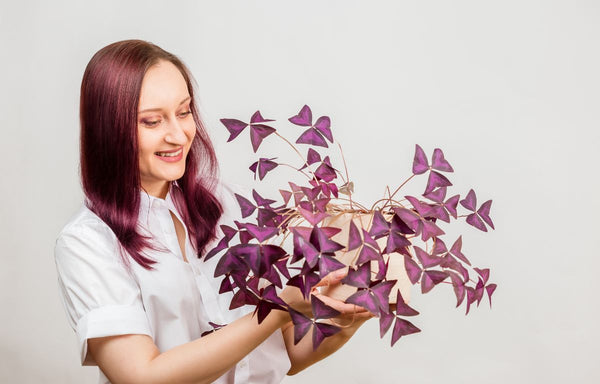
Plant Profile: Oxalis Triangularis or False Shamrock
In the world of indoor gardening, the Oxalis Triangularis, commonly known as the False Shamrock or Purple Shamrock, has become a favorite among plant lovers. With its eye-catching appearance, unique foliage, ability to tolerate low light, and easy-care requirements, it’s a popular choice for adding vibrant color to homes and gardens.

Origin and Characteristics
The Oxalis Triangularis originates from Brazil, specifically from the South American rainforests. Much like the Peace Lily, this low-growing species thrives on the forest floor, protected by larger plants that provide filtered sunlight. Because of its preference for indirect light, it’s a great option for indoor spaces with low lighting conditions.
One of the plant's most fascinating traits is its phototropic nature. This means that the Oxalis Triangularis moves in response to light, opening or closing its leaves based on the amount of sunlight it receives. The stunning purple or maroon color of its leaves is due to anthocyanin pigments, which increase in brighter light. In lower light, fewer pigments are produced, giving the leaves a more greenish hue. This change is natural and helps the plant conserve energy for growth.
Growing Oxalis Triangularis
Light:
The Oxalis Triangularis can adapt to lower light conditions, making it perfect for homes and apartments with limited natural light. However, for optimal growth and flowering, place your plant in an area with bright, indirect light. Be cautious with direct sunlight, as it can scorch the delicate leaves.
Watering:
During the growing season (spring and summer), keep the soil evenly moist. Water the plant when the top 1-2 inches of soil feel dry. Be sure to water thoroughly and allow excess water to drain out to avoid root rot. During its dormant period in fall and winter, reduce watering to match the plant's slower growth.
Soil and Potting:
Use a well-draining potting mix, ideally one that contains peat moss and perlite. The plant has a shallow root system, so choose a shallow pot that allows room for the roots to grow over time.
Temperature and Humidity:
The Oxalis Triangularis thrives in typical indoor temperatures, ideally between 60-75°F, with humidity levels around 40-60%. If your home tends to be dry, you can mist the plant, use a humidity tray, or place a humidifier nearby to maintain moisture.
Fertilization:
Regular fertilization will enhance your plant’s appearance and help it produce vibrant leaves and flowers. During the growing season, apply a balanced liquid fertilizer every 4-6 weeks at half strength. Reduce feeding during the dormant season.

Common Problems and Solutions
Drooping Leaves:
If the leaves droop, it may be a sign of under-watering or inconsistent watering. Adjust your schedule, making sure to water thoroughly but not too frequently, especially during the growing season.
Yellowing Leaves:
Yellowing can indicate overwatering or poor drainage. Ensure your pot has proper drainage and adjust your watering schedule as needed. Check soil moisture by inserting your finger into the top 2 inches—if it’s still wet, wait before watering again.
Pests:
Occasionally, pests like aphids, mealybugs, or spider mites may appear. Treat infestations with neem oil or organic insecticide, and isolate the plant if necessary. Remove affected parts of the plant to prevent the spread of pests.
Dormancy:
Oxalis Triangularis enters a natural dormancy in the winter, during which the plant may wilt or die back. Prune any dying leaves, reduce watering, and allow the plant to rest. This dormancy period encourages stronger growth in the spring.
Leggy Growth and Lack of Flowers:
If your plant becomes leggy, it may need more light. Move it to a brighter location and prune back any spindly stems to encourage bushier growth. Mature plants that receive more light and nutrients are also more likely to bloom.
Keen to read more? Learn how to care for a Jacaranda here.




